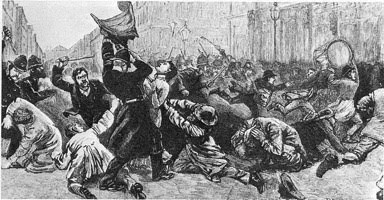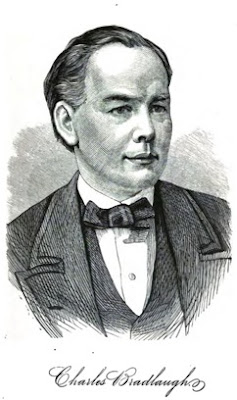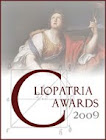I was driving home from work the other day, listening to music instead of audiobooks for a change; randomly playing the “top-rated songs” from my iPod. It’s surprising how songs you forgot you’d loved show up there from time to time. I found myself driving along to the
 snare-drum beat of U2’s 1983 hit, “Sunday Bloody Sunday,” which got me thinking about the events behind the song and about popular protest.
snare-drum beat of U2’s 1983 hit, “Sunday Bloody Sunday,” which got me thinking about the events behind the song and about popular protest.The U2 song refers to the 1972 shooting of unarmed protestors in Derry, Ireland. But the name Bloody Sunday has also been used to describe the reaction to the first Selma March (1965), police violence against unemployed protestors in Vancouver, BC (1938), a 1905 St. Petersburg massacre that helped spark the Russian Revolution, and two other days of violence in the Irish conflict (1920, 1921). The original Bloody Sunday was a November 1887 demonstration in London that was routed by the Army and Metropolitan Police.
The issues that led to 1887’s Bloody Sunday included the 1885-86 Irish Coercion Acts, but the demonstration was really a culmination of tensions brought on by England’s “Long Depression” of the 1870s. East Londoners had been demonstrating against unemployment and poverty in their section of London for several years. The difference in November of 1887 was, they marched westward with their protests, to Trafalgar.
The 1887 East End protestors were not the first to march on London’s centers of power. In 1848, Chartists had planned to march on Parliament, and had only been turned away when the Duke of Wellington placed cannons on the Westminster bridge over the Thames. But less than a generation later, Britain’s Reform League led demonstrations that brought hundreds of
 thousands of protestors to Trafalgar Square and Hyde Park in 1866, and to the Agricultural Hall and Hyde Park again in 1867. These protests had been declared illegal by government authorities. So how did the reformers “get away with” these massive demonstrations?
thousands of protestors to Trafalgar Square and Hyde Park in 1866, and to the Agricultural Hall and Hyde Park again in 1867. These protests had been declared illegal by government authorities. So how did the reformers “get away with” these massive demonstrations?The leaders of the Reform League demonstrations had learned from the 1848 intimidation of the Chartists. Charles Bradlaugh was an East Londoner who had been beaten by police at age 15, while leading an East London sympathy demonstration on the day the Chartists surrendered to Wellington. Bradlaugh was subsequently posted to County Cork with the British Army, where participating in the eviction of starving Irish peasants helped to radicalize him, and where he learned cavalry battle techniques and tactics. Bradlaugh insisted on public protests, against the wishes of many of his fellow Reform League leaders, and personally led them with the military discipline he had learned in Ireland.
200,000 Londoners marched on Hyde Park in July 1866. Home Secretary Spencer Walpole had outlawed the protest a few days earlier, and threatened military action. Bradlaugh and his radical allies in the Reform League leadership declared the government’s position unconstitutional, and announced they would challenge Walpole’s illegal attempt to bar peaceful, free assembly. Of course, in order to be legal, Bradlaugh realized the protest would have to be peaceful. And, aside from the famous destruction of some railings around the “Marble Arch” gate, which marchers led by a carriage of Reform League executives were prevented from entering by a troop of 1,600 police and soldiers, the demonstration was disciplined and nonviolent. Bradlaugh wasn’t at the railings, he was leading another column of protestors across Knightsbridge toward Hyde Park at the time.
To make a long story short, Spencer Walpole resigned in disgrace and the Reform League’s demonstrations established the right of Londoners to march, occupy public parks and squares, and demonstrate for their political rights. In 1868, the Reform Act passed, extending voting rights to working-class people for the first time in British history. And yet, twenty years later, Bloody Sunday. What had changed?

In 1887, Charles Bradlaugh was not at the head of the demonstration. He was exhausted and ill, following a six-year battle to take the seat in Parliament he’d been elected to in 1880. And he had doubts about the programs proposed by the Social Democratic Federation, which was sponsoring the protest. Bradlaugh advised readers of his National Reformer to stay away, and warned SDF and Fabian Society leaders to be cautious and consider the security of their people. Believing the precedent set by the Reform League had established their rights once and for all, Annie Besant, George Bernard Shaw, and the other leaders of the demonstration defied the government and marched. The results were disastrous.
Men, women, and children marchers were beaten by London police. Over two hundred people were hospitalized. Three were killed. Infantry and cavalry troops were on hand, with fixed bayonets; but luckily were not called into action. Several of the march’s leaders were arrested and held behind bars for six weeks.
It’s difficult to pinpoint all the factors that had changed, between 1866 and 1887. There was a new government, with new people in key positions—although in both cases, the Tories were in power. Chicago's Haymarket riot of 1886 was fresh in the minds of both the protestors and the government. The radicals who had been united behind the Reform League had split into factions. Socialists who seemed to be gaining ground in London political circles offered utopian ideals but had little connection with actual working people (the Labour Party was established in 1893, partly in response to these issues). But it’s possible that the key difference was the 1887 leaders’ belief that their right to protest, established 20 years earlier, was inviolable.
The lesson of Bloody Sunday, it seems to me, is that we can’t take our rights for granted. If we are not prepared to defend them, they can be taken from us. Like Charles Bradlaugh and his fellow reformers, we have to be resolute, disciplined, and nonviolent—but prepared to defend ourselves. It’s not insignificant that when Bradlaugh died four years after Bloody Sunday, one of the mourners at his simple secular funeral was twenty-one year old Mohandas Gandhi.






3 comments:
Sunday, Bloody Sunday is my favorite U2 song, and this is a terrific post. Nice-- although depressing!-- work, Dan.
I forced my nephew to both listen to the song and watch a Youtube concert version of it when he was studying the twentieth century Irish movement in his ninth grade history class. Thanks for putting it into context and drawing such a powerful lesson. It is especially poignant as we watch the Arab Spring this year.
Thanks! SBS is one of my favorite U2 songs too. Another is New Years Day -- the old version, with the final verse, "Gold is the reason for the wars we wage."
Post a Comment